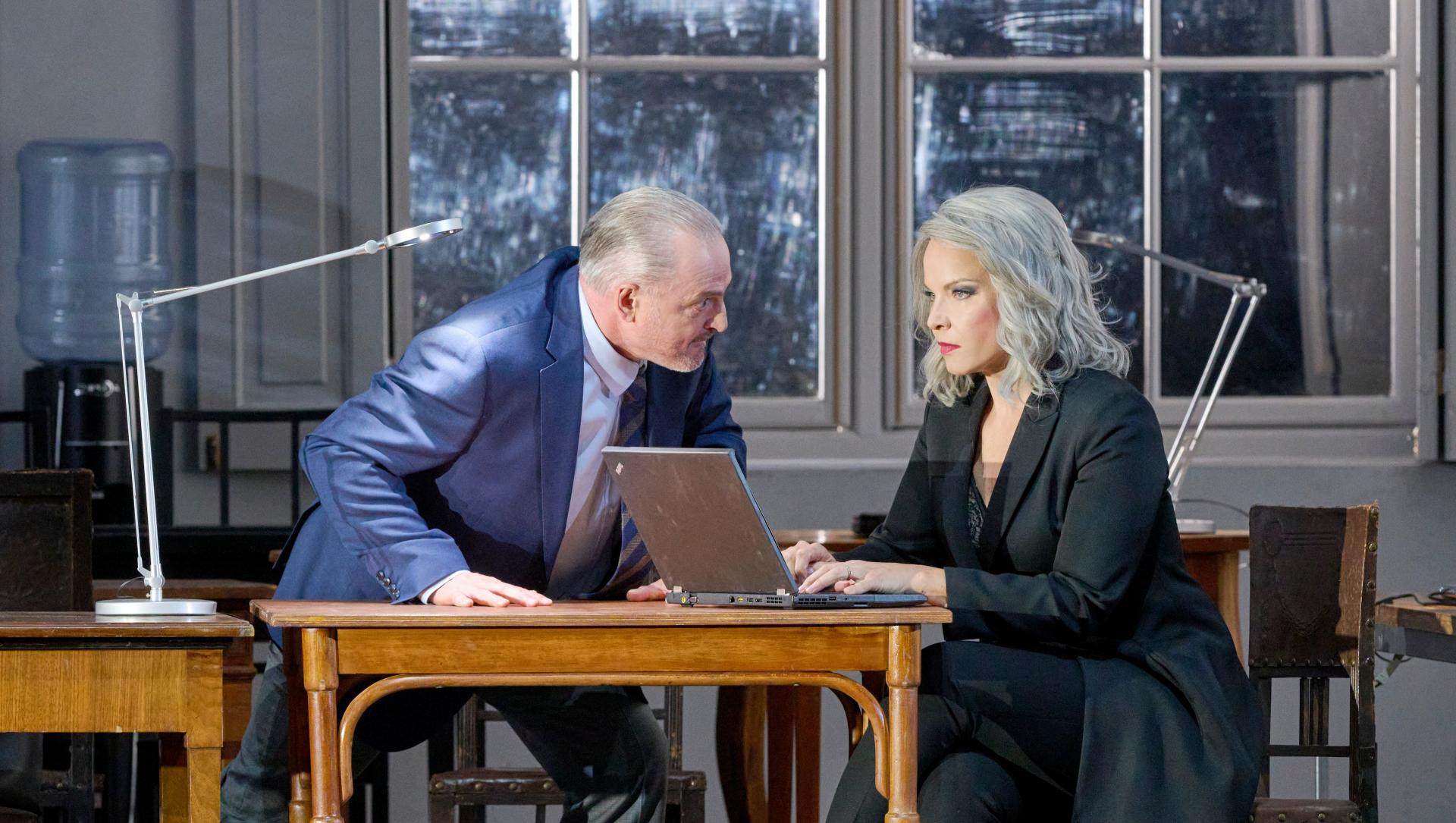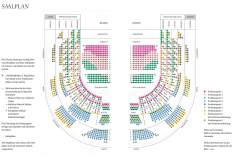Parsifal
Mo | Tu | We | Th | Fr | Sa | Su |
Parsifal - Richard Wagner | Opera
Stage consecration festival play in three acts
Text by Richard Wagner
Act 1: 100 minutes
Intermission: 30 minutes
Act 2: 70 minutes
Intermission: 30 minutes
Act 3: 70 minutes
Synopsis
ACT 1- ACT 3
The story takes place during the Christian reconquista on the Spanish peninsula, which was partly occupied by the Arabs.
The men's league of the Knights of the Holy Grail operating there has fallen into crisis. Time and again, knights desert to the counter-realm of the sorcerer Klingsor, who had emasculated himself in his quest for sexual asceticism and had previously been rejected by the circle of knights.
His castration gave Klingsor the power to dominate women. He now uses this power to bring down the chaste Christian knights. He was even able to tempt the Grail King Amfortas into a misstep, during which he stole his sacred spear and inflicted an incurable wound. As a result, Amfortas' ritual duty of unveiling the Grail has become an ordeal, which he only performs under pressure from his father "living in his grave" and refuses to do altogether after his death.
Only a "pure fool" is destined to reverse the Grail King's fall from grace and undo its devastating consequences. A decisive role in this work of redemption is played by an enigmatic woman who, under various identities, is on the move both on the grounds of the Grail Castle and in Klingsor's magical castle.
Program and cast
Amfortas: Ludovic Tézier
Gurnemanz: Günther Groissböck
Parsifal: Klaus Florian Vogt
Klingsor: Jochen Schmeckenbecher
Kundry: Anja Kampe
Musical direction: Axel Kober
Direction, stage & costumes: Kirill Serebrennikov
Light: Franck Evin
Co-director: Evgeny Kulagin
Stage collaboration: Olga Pavliuk
Costume collaboration: Tatiana Dolmatovskaya
Video & photo designer: Aleksei Fokin, Yurii Karih
Battlemaster: Ran Arthur Braun
Dramaturgy: Sergio Morabito
April 2026
Amfortas: Gerald Finley
Gurnemanz: Franz Josef Selig
Titurel: Matheus France
Parsifal: Klaus Florian Vogt
Klingsor: Werner Van Mechelen
Kundry: Jennifer Holloway
Musical direction: Axel Kober
Staging, stage & costumes: Kirill Serebrennikov
Light: Franck Evin
Co-Director: Evgeny Kulagin
Stage collaboration: Olga Pavluk
Costume collaboration: Tatiana Dolmatovskaya
Video & Photo Designer: Alexei Fokin; Yurii Karih
Combat Master: Ran Arthur Brown
Dramaturgy: Sergio Morabito
Vienna State Opera
Public Transport
Subway lines: U1, U2, U4
Trams: 1, 2, D, J, 62, 65
Buses: 59A
Local Railway: Badner Bahn
Stops: Karlsplatz / Opera
Taxi stands are available nearby.
Parking
Parking is only € 6, - for eight hours!
The Wiener Staatsoper and the ÖPARK Kärntner Ring Garage on Mahlerstraße 8, under the “Ringstraßengalerien”, offer the patrons of the Vienna State Opera a new, reduced parking fee. You can park in the Kärntner Ring Garage for up to 8 hours and pay only a flat fee of € 6, -. Just validate your ticket at one of the discount machines inside the Wiener Staatsoper. The normal rate will be charged for parking time greater than 8 hours. The validation machines can be found at the following coat checks: Operngasse, Herbert von Karajan-Platz, and the right and left and balcony galleries.
Important: In order to get the discount, please draw a ticket and do not use your credit card when entering the garage!
After devaluing your ticket in the Wiener Staatsoper you can pay comfortably by credit card or cash at the vending machines.
The machines accept coins and bills up to 50.- Euro. Parking time longer than 8 hours will be charged at the normal rate.
History
The structure of the opera house was planned by the Viennese architect August Sicard von Sicardsburg, while the inside was designed by interior decorator Eduard van der Nüll. It was also impacted by other major artists such as Moritz von Schwind, who painted the frescoes in the foyer, and the famous "Zauberflöten" (“Magic Flute”) series of frescoes on the veranda. Neither of the architects survived to see the opening of ‘their’ opera house: the sensitive van der Nüll committed suicide, and his friend Sicardsburg died of a stroke soon afterwards.
On May 25, 1869, the opera house solemnly opened with Mozart's Don Giovanni in the presence of Emperor Franz Joseph and Empress Elisabeth.
The popularity of the building grew under the artistic influence of the first directors: Franz von Dingelstedt, Johann Herbeck, Franz Jauner, and Wilhelm Jahn. The Vienna opera experienced its first high point under the direction of Gustav Mahler. He completely transformed the outdated performance system, increased the precision and timing of the performances, and also utilized the experience of other noteworthy artists, such as Alfred Roller, for the formation of new stage aesthetics.
The years 1938 to 1945 were a dark chapter in the history of the opera house. Under the Nazis, many members of the house were driven out, pursued, and killed, and many works were not allowed to be played.
On March 12, 1945, the opera house was devastated during a bombing, but on May 1, 1945, the “State Opera in the Volksoper” opened with a performance of Mozart's THE MARRIAGE OF FIGARO. On October 6, 1945, the hastily restored “Theaters an der Wien” reopened with Beethoven's FIDELIO. For the next ten years the Vienna State Opera operated in two venues while the true headquarters was being rebuilt at a great expense.
The Secretary of State for Public Works, Julius Raab, announced on May 24, 1945, that reconstruction of the Vienna State Opera would begin immediately. Only the main facade, the grand staircase, and the Schwind Foyer had been spared from the bombs. On November 5, 1955, the Vienna State Opera reopened with a new auditorium and modernized technology. Under the direction of Karl Böhm, Beethoven’s FIDELIO was brilliantly performed, and the opening ceremonies were broadcast by Austrian television. The whole world understood that life was beginning again for this country that had just regained its independence.
Today, the Vienna State Opera is considered one of the most important opera houses in the world; in particular, it is the house with the largest repertoire. It has been under the direction of Dominique Meyer since September 1, 2010.

 EN
EN DE
DE IT
IT FR
FR ES
ES RU
RU JP
JP RO
RO
 Seating plan
Seating plan 

